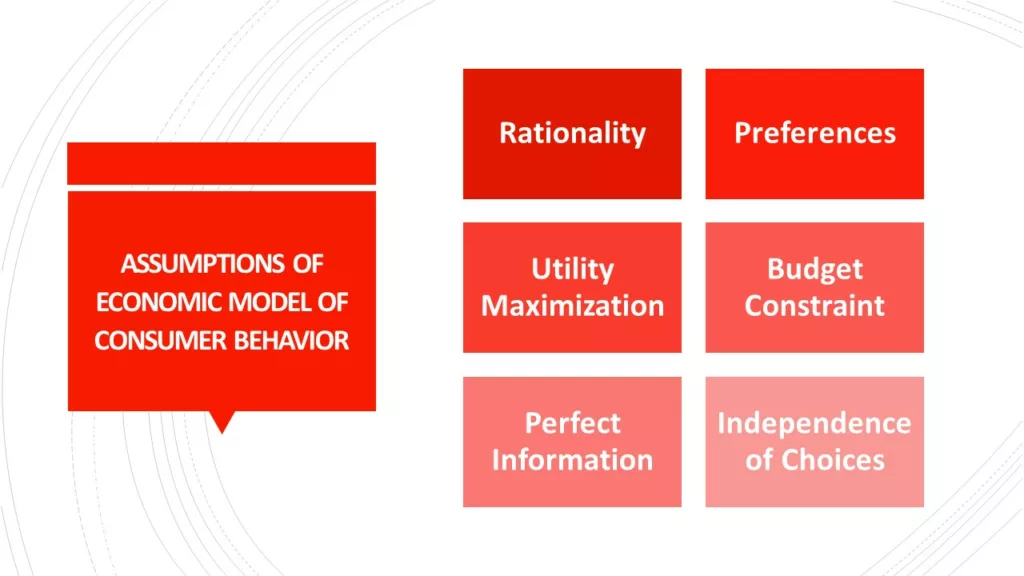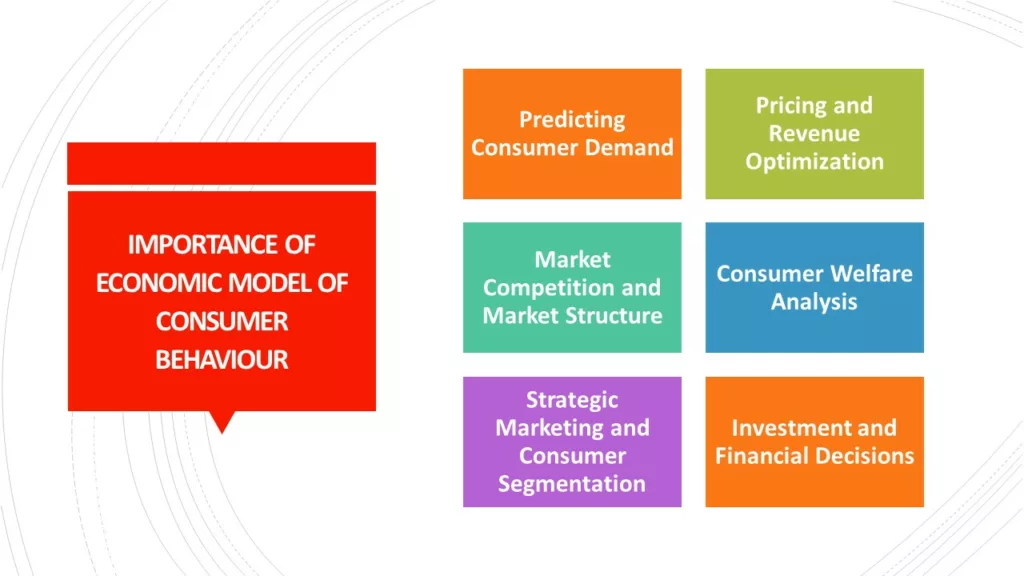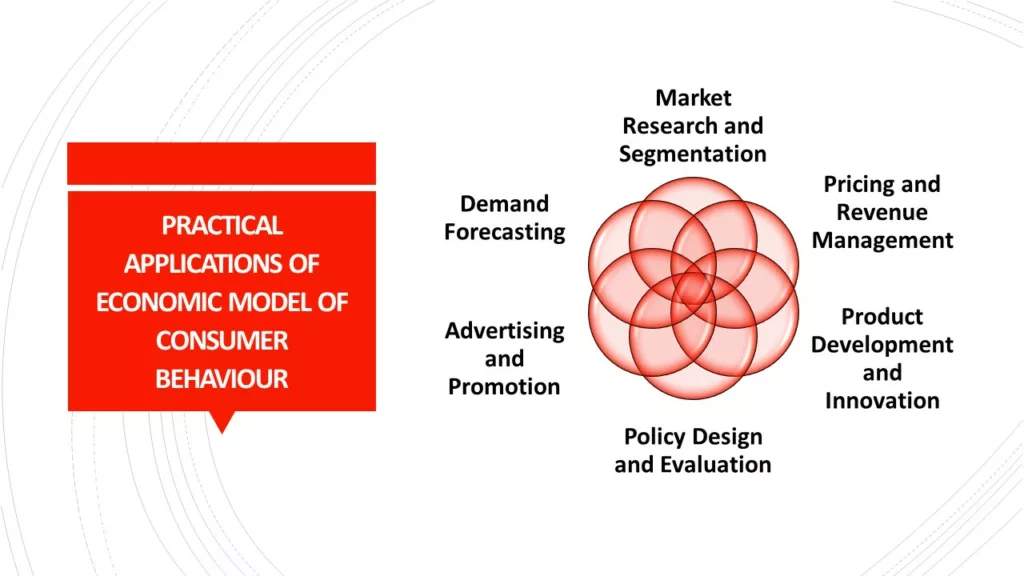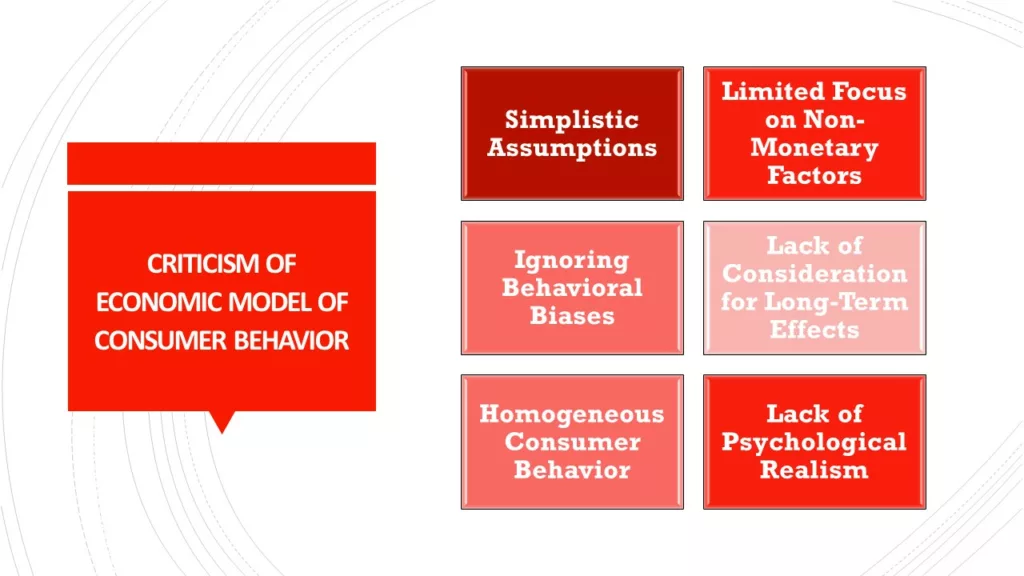ECONOMIC MODEL OF CONSUMER BEHAVIOR
The economic model of consumer behavior is a framework that seeks to understand how individuals make decisions regarding the purchase and consumption of goods and services. It is based on the assumption that consumers are rational beings who aim to maximize their overall satisfaction or utility, given their limited resources.
This model takes into account various factors that influence consumer behavior, such as income, prices, preferences, and the availability of substitutes. By analyzing these factors, economists can gain insights into consumer choices and predict how changes in economic variables might affect consumer behavior. The economic model of consumer behavior serves as a foundation for understanding market demand and helps businesses and policymakers make informed decisions regarding production, pricing, and marketing strategies.
ASSUMPTIONS OF ECONOMIC MODEL OF CONSUMER BEHAVIOR
The economic model of consumer behavior is built upon several key assumptions that provide a foundation for understanding and analyzing consumer choices. These assumptions serve as simplifications of reality and provide a framework for economic analysis. Here are some of the main assumptions of the economic model of consumer behavior:

- Rationality: The model assumes that consumers are rational decision-makers who have well-defined preferences and make choices based on their self-interest. Rational consumers aim to maximize their overall satisfaction or utility, given their limited resources.
- Preferences: Consumers have consistent preferences and can rank different goods and services based on their subjective evaluations of utility. These preferences are stable over time and can be used to make choices among various alternatives.
- Utility Maximization: Consumers seek to maximize their utility, which represents the satisfaction or well-being they derive from consuming goods and services. The model assumes that consumers allocate their resources in a way that maximizes their utility within the constraints of their budget.
- Budget Constraint: Consumers face limited income or budgetary constraints. The model assumes that consumers have a fixed amount of income that they can allocate towards purchasing goods and services. The prices of goods and services, along with the consumer’s income, determine the feasible set of choices available to them.
- Perfect Information: The economic model assumes that consumers have access to complete and accurate information about the characteristics, quality, and prices of goods and services. This assumption allows consumers to make informed choices and evaluate the costs and benefits of different options.
- Independence of Choices: The model assumes that consumer choices are independent of each other. In other words, the decision to consume or purchase one good does not directly affect the utility derived from consuming another good. This assumption enables the analysis of individual consumer choices in isolation.
It’s important to note that while these assumptions simplify the complexity of real-world consumer behavior, they provide a useful framework for economic analysis and understanding market dynamics.
IMPORTANCE OF ECONOMIC MODEL OF CONSUMER BEHAVIOUR
The economic model of consumer behavior holds significant importance in understanding and analyzing consumer choices and market dynamics. Here are some key reasons why the economic model is valuable:

- Predicting Consumer Demand: The economic model helps predict consumer demand by examining how consumers allocate their limited resources (such as income) among different goods and services. By understanding the factors that influence consumer preferences and choices, economists can make informed predictions about consumer demand for specific products or brands. This information is crucial for businesses to plan production, inventory, pricing, and marketing strategies.
- Pricing and Revenue Optimization: The economic model provides insights into consumer price sensitivity and elasticity of demand. It helps businesses determine optimal pricing strategies to maximize revenue and profitability. By understanding how changes in price influence consumer behavior, businesses can set prices that balance maximizing revenue with maintaining market share. The economic model also helps in evaluating the impact of pricing strategies, such as discounts, promotions, and dynamic pricing, on consumer behavior and overall market outcomes.
- Market Competition and Market Structure: The economic model of consumer behavior plays a crucial role in analyzing market competition and market structure. It helps identify market segments, assess the market power of firms, and understand the impact of entry barriers, product differentiation, and pricing strategies on market outcomes. By understanding consumer behavior within the economic framework, policymakers and businesses can make informed decisions regarding market regulation, antitrust measures, and market entry strategies.
- Consumer Welfare Analysis: The economic model enables the evaluation of consumer welfare, which is the satisfaction or well-being derived from consuming goods and services. By analyzing consumer behavior and choices, economists can assess the impact of various factors, such as changes in prices, income, or market conditions, on consumer welfare. This information is valuable for policymakers and regulators in making decisions that aim to enhance consumer welfare, such as implementing consumer protection measures or evaluating the effects of market interventions.
- Strategic Marketing and Consumer Segmentation: The economic model helps businesses develop strategic marketing plans and target specific consumer segments. By understanding consumer preferences, price sensitivity, and demand elasticity, businesses can tailor their marketing efforts to effectively reach and influence target consumers. The economic model assists in identifying profitable market segments, designing product features, developing pricing strategies, and allocating marketing resources based on consumer behavior and market dynamics.
- Investment and Financial Decisions: The economic model of consumer behavior provides valuable insights for investors and financial decision-makers. By understanding consumer behavior and market dynamics, investors can assess market potential, evaluate investment opportunities, and make informed decisions regarding resource allocation. Consumer behavior analysis helps in understanding consumer demand for specific industries or sectors, which assists investors in making investment decisions and managing risk.
In summary, the economic model of consumer behavior plays a crucial role in understanding and analyzing consumer choices, predicting market outcomes, and informing business strategies. By examining consumer preferences, demand patterns, and market dynamics through an economic lens, businesses, policymakers, and investors can make more informed decisions, optimize resource allocation, and enhance market efficiency.
REAL LIFE OR PRACTICAL APPLICATIONS OF ECONOMIC MODEL OF CONSUMER BEHAVIOUR
The economic model of consumer behavior has several practical applications that can help businesses, policymakers, and marketers make informed decisions. Here are some examples:

- Market Research and Segmentation: The economic model of consumer behavior provides a framework for conducting market research and understanding consumer preferences. By analyzing consumer choices and preferences, businesses can segment their target markets and tailor their products, pricing, and marketing strategies to specific consumer groups. This helps in identifying niche markets, designing effective advertising campaigns, and developing products that align with consumer preferences.
- Pricing and Revenue Management: The economic model helps businesses determine optimal pricing strategies. By understanding how consumers respond to changes in prices, businesses can set prices that maximize their profits. This includes analyzing price elasticity of demand to identify price-sensitive segments and implementing dynamic pricing strategies to adjust prices based on market conditions and consumer behavior.
- Product Development and Innovation: Understanding consumer behavior helps businesses identify opportunities for new product development and innovation. By analyzing consumer preferences, needs, and desires, businesses can develop products that align with consumer demands and differentiate themselves in the market. This can involve conducting surveys, focus groups, or analyzing purchasing patterns to identify gaps in the market and develop products that offer unique value propositions.
- Policy Design and Evaluation: Policymakers can utilize the economic model of consumer behavior to design and evaluate policies related to taxation, regulation, and consumer protection. By understanding how consumers respond to changes in policy variables, policymakers can assess the potential impacts of policy interventions and design regulations that promote consumer welfare and market efficiency.
- Advertising and Promotion: The economic model helps businesses develop effective advertising and promotional strategies. By understanding consumer preferences and the factors that influence consumer behavior, businesses can create targeted advertising campaigns that resonate with their target audience. This includes identifying the right channels, messages, and incentives to influence consumer choices and increase brand awareness and sales.
- Demand Forecasting: The economic model enables businesses to forecast consumer demand for their products or services. By analyzing historical data, market trends, and consumer behavior, businesses can estimate future demand and adjust their production, inventory, and supply chain management strategies accordingly. This helps in optimizing resource allocation and managing production costs.
Overall, the practical applications of the economic model of consumer behavior extend to various areas of business management, marketing, policymaking, and strategic decision-making. By understanding consumer preferences, choices, and decision-making processes, businesses and policymakers can make more informed decisions and enhance their competitive advantage in the market.
CRITICISM OF ECONOMIC MODEL OF CONSUMER BEHAVIOR
While the economic model of consumer behavior has proven to be a valuable framework for analyzing consumer choices and market dynamics, it is not without its criticisms. Here are some common criticisms:

- Simplistic Assumptions: The economic model assumes that consumers are rational decision-makers with perfect information and consistent preferences. However, in reality, consumers may not always make perfectly rational decisions, have complete information, or have stable preferences. The model’s assumptions oversimplify the complexity of human behavior and may not capture the full range of factors that influence consumer choices.
- Limited Focus on Non-Monetary Factors: The economic model primarily focuses on monetary factors, such as prices and income, and overlooks the influence of non-monetary factors on consumer behavior. Factors such as social norms, cultural values, psychological influences, and personal experiences play a significant role in shaping consumer choices but are not adequately captured in the economic model.
- Ignoring Behavioral Biases: The economic model assumes that consumers always make optimal decisions to maximize their utility. However, behavioral economics research has demonstrated that individuals often exhibit biases and heuristics that lead to systematic deviations from rational decision-making. Biases such as loss aversion, status quo bias, and present bias can significantly impact consumer choices but are not explicitly accounted for in the economic model.
- Lack of Consideration for Long-Term Effects: The economic model often focuses on short-term decision-making and may not adequately capture the long-term consequences of consumer choices. Consumers’ preferences and utility functions may evolve over time, and decisions made in the short run may not align with long-term well-being or sustainability. For example, consumers may prioritize immediate gratification over long-term benefits, leading to suboptimal outcomes from a societal or environmental perspective.
- Homogeneous Consumer Behavior: The economic model assumes that all consumers are identical and make choices based solely on their individual preferences and constraints. However, consumer behavior can vary significantly across different segments, demographics, and cultural contexts. The model’s assumption of homogeneous consumer behavior may not capture the heterogeneity and diversity in actual consumer choices.
- Lack of Psychological Realism: The economic model often neglects the psychological aspects of consumer behavior, such as emotions, cognitive biases, and social influences. These psychological factors play a crucial role in shaping consumer choices but are not explicitly incorporated into the model. Integrating insights from psychology and behavioral sciences can provide a more comprehensive understanding of consumer behavior.
It’s important to note that while these criticisms highlight limitations and shortcomings of the economic model of consumer behavior, it still offers valuable insights and serves as a foundational framework for analyzing consumer choices. However, incorporating more nuanced and realistic elements into the model can enhance its effectiveness in understanding and predicting consumer behavior.